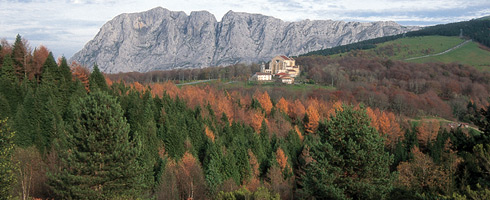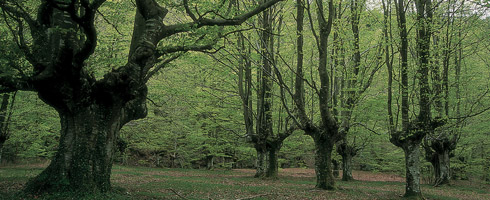Parque Natural de Urkiola · Ayuntamiento de Abadiño
Situación
Menú principal

The Urkiola landscape is covered by a thick layer of vegetation, which is only broken by the steep limestone summits. The Parque’s vegetation is made up of various plant communities, where forests account for the largest surface area (3,200 Ha). Over half (1,680 Ha) of all the forested areas are natural beech, Holm Oak, Oak, birch and Pyrenean oaks. The rest is mainly made up of conifer plantations. Apart from the forests, mountain pastureland is one of the key characteristics of the Urkiola landscape, but we should not forget that a large number of unusual plants thrive the rocky summits and wetlands of the streams and peat bogs.
Nearly 700 species make up the park's flora and each has its own optimum habitat where it can grow. Many of those plants are grouped under similar environmental conditions and form clearly identifiable plant communities. The beech forest, for example, is one of the most extensive in Urkiola and nearly always grows over 600 metres, where the conditions are damp enough for the beech and accompanying flora to thrive.
The region's fresh and rainy climate, the various types of soil (rocky, rich in nutrients, etc) and the steep slopes of these mountains directly influence the vegetation, but these are not the only factors to be taken into account if we want to understand the distribution of the plants. Climatic changes and movements of the tectonic plates throughout the history of the Earth are also of great importance, along with the interaction between man and his environment over the centuries.
The vegetation in the Urkiola Natural Park has not always been the same as we can see today. It is easy to realise that, if we just imagine there were no pines, larches or cypresses on these mountains 500 hundred years ago. They were planted by the local inhabitants to obtain wood and now cover large areas and an important part of the plant landscape. The human presence is also reflected in the Saibi and Urkiolagirre beech forests, where centuries-old pollarded beeches that provided wood to the Urkiola charcoal burners for many years. The current vegetation therefore reflects and is the result of a large process of historical changes.

2006 - 2007 © Anteiglesia de Abadiño Town Council - All rights reserved